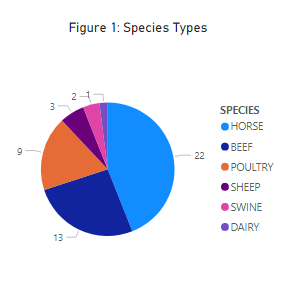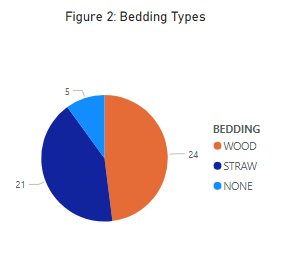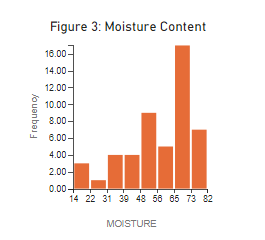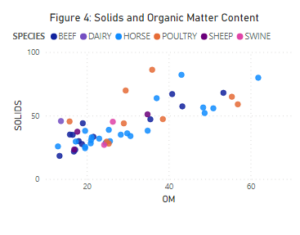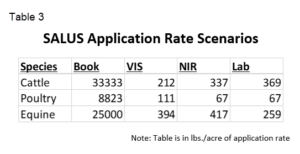Final report for GNC19-290
Project Information
While the incorporation of manure has been noted as a fundamental component of sustainable agricultural systems, nutrient management practices for these materials have languished. Traditional laboratory analyses of organic amendments are slow, time consuming and expensive, leading to relatively limited adoption. These methods also mainly quantify macronutrient contents, representing an antiquated notion of nutrient management based simply on achieving cumulative nutrient removal. Analyzing both the elemental content and chemical structure of a specific manure is vital to synchronizing the mineralization of nutrients (supply) with the needs of crop uptake (demand) in sustainable agricultural systems.
Small farms often manage solid manure, which tends to be quite variable in both nutrient quantity and timing availability. A simple, rapid and low-cost method for onsite manure composition analysis would vastly improve nutrient management on these operations. Visible and near-infrared reflectance (VIS- NIR) measurements of manure have been successfully calibrated to both traditional laboratory extractions (moisture, total carbon and nitrogen) and measurements of organic chemical composition (cellulose and lignin)1. While VIS-NIR has been validated extensively on a vast array of organic materials in research settings with great success, technological advances are only now making cost effective portable devices a reality.
This project will examine different methods for onsite testing of manure composition using a full spectroradiometer and low-cost reflectometer. The developed calibrations will be validated, then used in simulations within the Systems Approach to Land Use Sustainability (SALUS) Model to evaluate the long-term dynamics of manure decomposition and its effects on crop yield and soil health. SALUS is a crop and soil biogeochemical model designed to simulate continuous crop, soil, water and nutrient conditions under different management strategies for multiple years. Long term simulations will be used to calculate expected economic and environmental impacts, and to assess the potential of onsite VIS-NIR for precision manure management.
- Althaus, B., Papke, G., and A. Sundrum. Use of near infrared reflectance spectroscopy to assess nitrogen and carbon fractions in dairy cow feces. Anim. Feed & Tech. 185, 53-59.
Project participants will gain knowledge on the critical role of nutrient content and biological nature of manures. Refining the rate and timing of manure application based on this understanding will be a key takeaway. Participants will also gain a basic overview of spectral science, and why absorbance of energy by materials might aid in prediction of their makeup. The possibility of realizing improved manure management through rapid, low cost and onsite VIS-NIR analysis yielding both nutrient content and biological composition of manures will be demonstrated. Modeling and visualization will further assist in conveying these concepts in real world scenarios. The current viability and economics of adopting portable spectroscopic technology will be summarized concisely for consideration by those making business decisions.
Actions based on these learning outcomes will principally include modification of manure management plans (MMPs). Limited resource farmers and those consulting them will modify practices based on potential economic and environmental improvements achieved by accounting for both the nutrient content and chemical composition of manures. A smaller subset of progressive producers and consultants will also adopt the use of spectral devices and improve management of manure variability and temporal nutrient cycling through expanded spectral analysis of manures and soils.
Cooperators
- (Educator)
Research
As described in the project proposal, this project collected composite solid manure samples from 50 limited resource farmers. These comprised a number of common agricultural species and bedding types as shown in figures 1 and 2. These samples were taken as representative composite "grab" samples from animal housing or temporary storage locations. Samples were then mixed in a plastic bucket using a plastic mixing tool, then placed in air tight plastic storage bags. All samples were then divided and subsequently frozen. After pooling for batch processing, subsamples were sent to A & L Laboratories for traditional chemical analysis of an array of manure properties including moisture, ash content, organic matter, organic carbon, total Kjeldahl nitrogen, phosphorus, potassium, a broad array of minerals and acid detergent fiber. Moisture content and species specific relationships between solid content and organic matter content are shown in figures 3 and 4.
Identical subsamples were then processed using three levels of sample preparation designed to be low-cost and feasible in-situ. One subsample underwent no processing whatsoever. The next subset was simply ground using 3 one second pulses on a traditional coffee grinder. The final subset was ground as previously described, then additionally dried via microwave for 3 minutes, stirred and microwaved for an additional 3 minutes. These subsamples were refrozen and subsequently analyzed using a Si-Ware Neospectra NIR spectrometer measuring 145 bands in the 1351-2561 nm range and a simple low-cost Our-Sci reflectometer measuring 9 bands of visible spectra from 365-940 nm range. All preparations were scanned three times using the Our -Sci reflectometer and averaged to create the VIS values. Only the fully processed samples were scanned 3 times using the Si-Ware Neospectra and subsequently averaged for the NIR readings.
Accompanying laboratory and spectral data were then analyzed for relationships using R software. Models were built for the VIS data using stepwise linear regression for variable selection and manual selection of the final linear regression model. Given dimensionality issues in the NIR dataset, principle component regression (PCR) and partial least squares (PLS) were utilized. Models were selected based on cross validation scores, choosing the model with the lowest mean squared error of prediction (MSEP). Ultimately, PLS models were chosen for predictions in the subsequent SALUS crop modeling exercise given their increased flexibility and generally superior performance to (PCR).
Laboratory analysis provided a vast number of chemical variables on which to construct models. However, as predicted by previous literature, only a small number of these demonstrated any correlation with VIS-NIR reflectance. Many chemical constituents presented inconsistent relationships in the modest sample size and high degree of heterogeneity in the samples collected. As described in the methods, livestock species and manure handling systems varied dramatically among participants. Even in a more homogenous sample, there exists little theoretical basis for VIS-NIR correlations with many of the mineral constituents given the lack of specific spectral signatures of these elements. This lack of relationships with low content mineral constituents of livestock manure was expected.
One of the key hypothesis of the project proposal was that VIS-NIR readings may be able to calibrate nutrient mineralization pools for subsequent crop modeling. This hypothesis was tested via laboratory measurements of Acid Detergent Fiber (ADF), specifically representing cellulose and hemi-cellulose pools in the SALUS model. Overall, this was not successfully calibrated, although some anticipated correlation can be seen in samples with wood bedding in figure 5. Other potential pool initializing parameters like ash content could be observed in exclusively straw beddings as depicted in figure 6. However, these did not represent dependable results that would provide reliable collaborations for the types of mixed manure and bedding systems represented in this project. Further and more expanded study could establish reliable models for specific livestock species and systems. However, improved direct initiation of crop model mineralization pools using VIS-NIR across heterogenous animal manures was not achieved.
Yet, as additionally hypothesized, VIS-NIR could characterize solid manures as related to several key constituents on which agronomic decisions are made. Relationships with total Kjeldahl nitrogen (TKN), total carbon (TC) and moisture content (MC) were observed. Models were then built for both VIS and NIR spectra with each of these measures as the response variable. VIS models utilized stepwise linear regression to select relevant bands, while the much larger NIR models were built on Principle Component Regression (PCR) and Partial Least Squares (PLS). Across both ranges of spectra, these models generally performed well in describing these characteristics, as described in tables 1 and 2 below. Since most limited resource farmers currently use published values to characterize their manure, VIS-NIR technology that quickly and efficiently characterizes livestock waste could lead to economic and environmental benefits.
To demonstrate this, TKN was chosen for model simulation utilizing the SALUS model as described in the project proposal. MC and TC could be extremely valuable future variables in managing water quality and quantifying carbon sequestration respectively. However, at present most manure application decisions are based on phosphorus (P) or TKN rates. SALUS simulation was undertaken at three species and site locations considered to be generally representative of the project data set. VIS-NIR predictions for application rates to supply crop needs for TKN were then made using VIS linear and NIR PLS models developed. Models were constructed for a pre planting application of manure ahead of a typical corn crop. Simulations will be conducted for producers selecting application rates of TKN based on published values, VIS, NIR and finally per the actual laboratory analysis. The applicable scenario rates are shown below in table 3.
Model simulations results are an integral part of the quantification and illustration of the impacts of this project. However, due to COVID-19 restrictions on laboratory access and in-person gatherings, this simulation work is still in process. When completed, the SALUS runs will allow for a direct quantification of the economic and environmental impact of these various manure application rate scenarios, including impacts on potential yield and nitrogen leaching. In addition, utilizing historical and projected climate pathways, simulation can even examine the impact of climate change on the importance of manure management. These simulations can also demonstrate how quantifying manure carbon content as demonstrated in this study can potentially be meaningful in predicting subsequent soil carbon sequestration. As ecosystem service markets develop, VIS-NIR could represent a valuable tool in agricultural carbon accounting.
Educational & Outreach Activities
Participation Summary:
As described in the project proposal, the primary method of outreach was designed to be onsite consultations with limited resource farmers. The COVID-19 pandemic made it necessary to modify this outreach methodology. While sample collection was still conducted onsite, the pandemic made it necessary to abandon many of the face to educational aspects of this project. Some in person socially distanced learning was still conducted, depending on the relevant gathering restrictions at that point in time. However, the extension aspect of field consultations on manure management was severely hampered due to public health restrictions.
To compensate for some of this, additional unplanned outreach is being undertaken to summarize research findings and distribute these electronically to participants along with additional helpful resources for manure management. These are still in progress, but are focused on being accessible and relevant to the limited resource farmers involved in the study. In addition, more academically focused dissemination is also planned via submission to several journals for potential publication.
Project Outcomes
Our study results show that readily accessible VIS-NIR technologies can assist farmers in successfully characterizing solid animal manures. This is especially relevant in a context where many farmers, especially limited resource farmers, do not analyze and consequently do not efficiently manage these materials. The effects of generalizing manure content based on published standards is clearly illustrated in the modeling exercise.
As such, these techniques can substantially decrease the environmental impacts of manure application, improve producer profitability, and even assist in managing carbon sequestration to combat climate change. With inexpensive ways to better understand agricultural wastes, farmers can clearly improve decision making. However, at the same time policy institutions can also be designed to more efficiently integrate with the diverse conditions facing limited resource livestock farmers around the world.
While likely similar to many of the other grantees during this specific reporting period, this project was made much more difficult due to the pandemic. In the state in which this work took place, numerous waves of shutdowns were somewhat crippling to the planned activities. However, this also may have fostered creativity in finding ways to complete study and examination of the initial hypothesis.
The ultimate finding was extremely meaningful in demonstrating a very viable application of VIS-NIR technologies, but also illustrated additional benefits of these flexible techniques. While laboratories remained close for weeks or months, such novel techniques could remain viable options during future public health emergencies. In fact, one of the strengths of "sustainable agriculture" is a capacity for resilience and adaptation. That is exactly what our project team was forced to do in this instance, with the ultimate finding that these techniques could still be effective.
The only comment in this regard would be that larger more comprehensive studies would be beneficial on this and similar applications. Digital agricultural holds tremendous potential to help not only large commercial farmers, but limited resource farmers as well. The low cost information that can be furnished by these technologies can assist limited resource producers in a number of potential applications.
